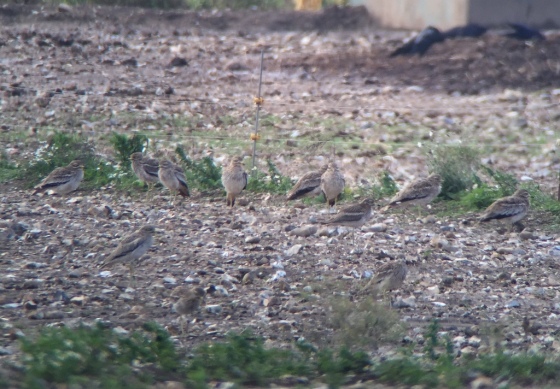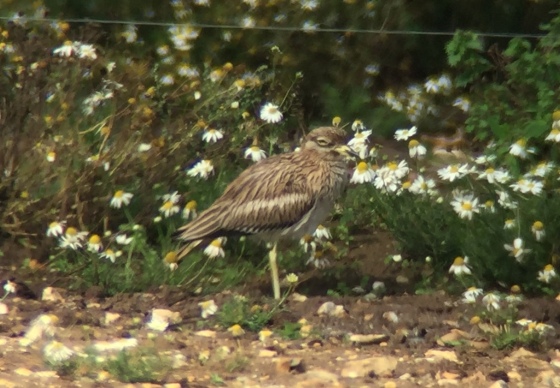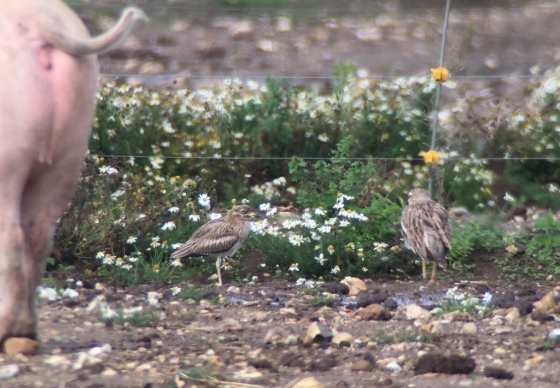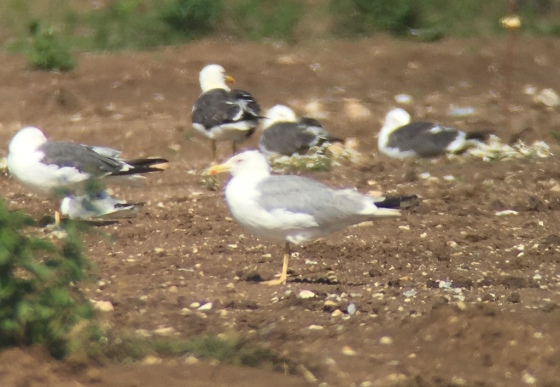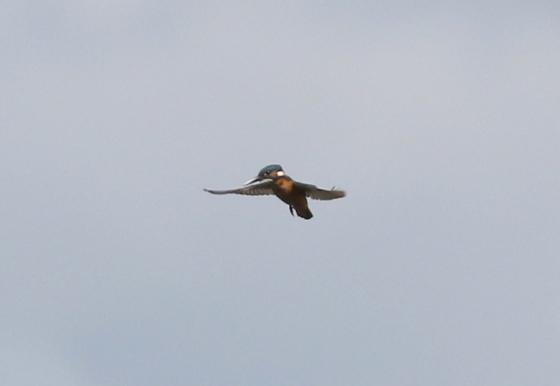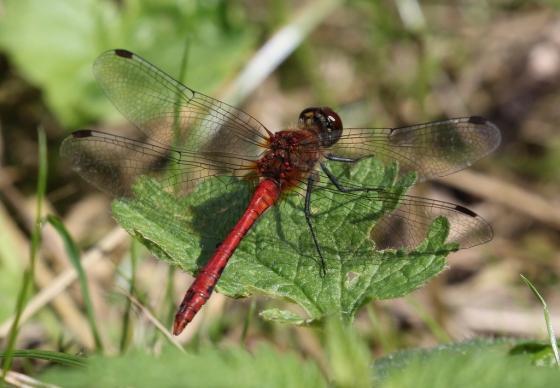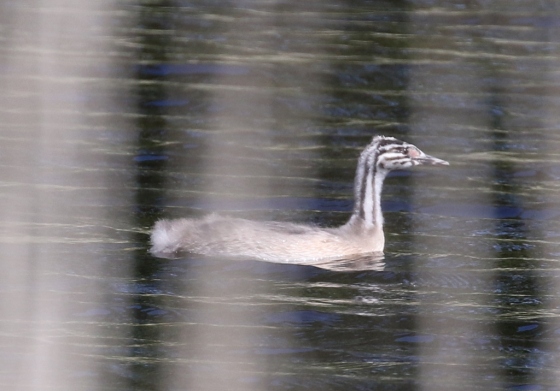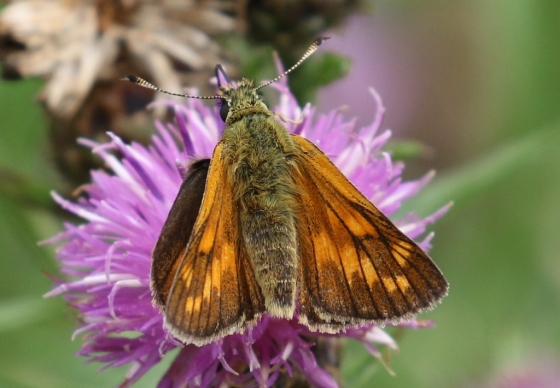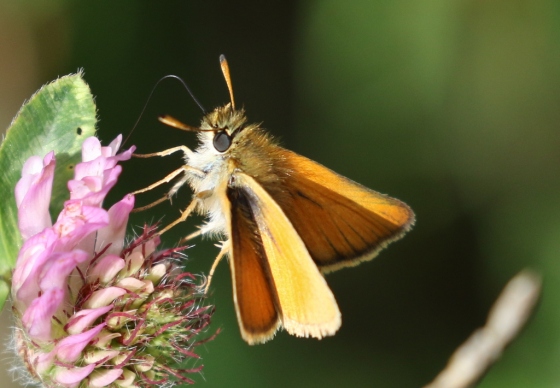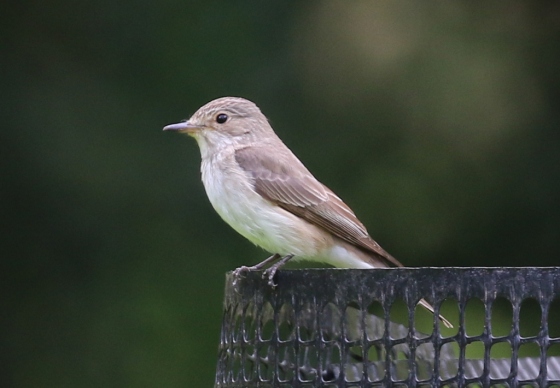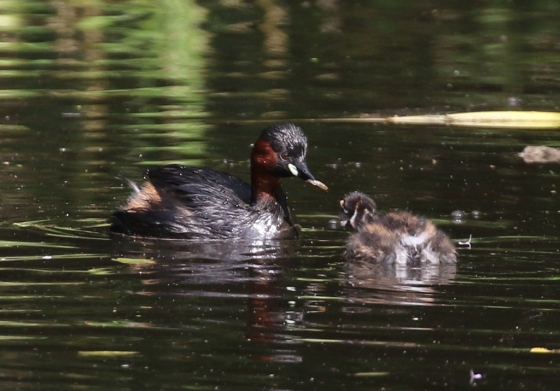Below is a copy of Marcus' report.
Day 3 of a three day Summer Tour today, our last day. It was a lovely day to be out, bright with some nice spells of sunshine, slightly less windy than recent days. We set off down to the Brecks.
Our first target was to look for Stone Curlews. At our first stop, a favourite site for them, we pulled up at a gateway and immediately saw four out in a field of pigs. A great start. They were some distance away, so we got out of the car, but as we approached the gate we could see there were more there, at least 10 together in a group, hiding along the edge of the field. What we didn't realise was that there were many more still, and some were much closer to us, hidden behind a line of tall weeds. Unfortunately they spooked. All of the Stone Curlews took off and we were amazed how many actually were hiding there, we counted 35 in total in the flock as they flew.
Stone Curlews - some of the 35 after they flew out into the middle of the field
Thankfully the Stone Curlews landed again just a little further out. While we were watching them, what appeared to be a different group of ten flew in overhead and out into the field to join them. We couldn't believe it - 45. However, even then we weren't finished. We could hear more Stone Curlews calling, away to our right, and looked over to see another ten. At least 55 Stone Curlews!
Stone Curlew - loafing and preening around the fields
We watched the Stone Curlews for some time. They were settled now. Some went to sleep, others were preening. Most moved round until they were tucked back up against the lines of taller vegetation. They usually gather into flocks at the end of the breeding season, but this seems rather early for there to be so many Stone Curlews here. Regardless, it was a fantastic experience, watching so many of them. The group were rendered quite speechless for a while!
Stone Curlews - the pigs occasionally got in the way!
Eventually we had to tear ourselves away. We drove round to another set of pig fields, where there are often large groups of gulls gathering at this time of year. Sure enough, we found a large flock of Lesser Black-backed Gulls here, so we stopped to scan through them. We found a couple of Yellow-legged Gulls, nice adults with medium grey backs, much paler than the Lesser Black-backs but darker then a Herring Gull, and bright yellow legs.
Yellow-legged Gull - with Lesser Black-backed Gulls in the pig fields
Our next stop was over at Lakenheath Fen. We stopped briefly at the Visitor Centre to get an update on what was showing today and were surprised to hear that the Cranes seemed to have flown off already, a couple of days earlier. This is very early this year, as they do not normally leave for the winter until later in August. That was disappointing as we had hoped to see them here today, but still, we went out onto the reserve for a quick look to see what we could find.
New Fen looked quiet at first, with just a family of Coot and a Moorhen on the pool. We picked up a couple of falcons circling over West Wood. The first was a Kestrel, but the second looked more interesting. We got it in the scope and confirmed it was a Hobby. We could see lots of Swifts and hirundines high in the sky over the river. The Hobby circled up, climbing above them, until we eventually lost sight of it in the clouds.
A Kingfisher flew over and disappeared into the trees, just a flash of blue too quick for everyone to see. We could hear it or another calling from the wood behind us, presumably where it is nesting. A little later, it appeared again, and this time hovered for some time, a minute or so, high above a patch of open water in the reeds so that everyone could get a good look at it.
Kingfisher - hovering over the reeds
Reed Warblers kept zipping back and forth low over the water, in and out of the patch of reeds in the middle of the pool. We heard Bearded Tits calling at one point but it was still a bit breezy today and they kept themselves tucked down in the reeds.
Continuing on across the reserve, we stopped to look at several different dragonflies. There were several different hawkers out - golden-brown-winged Brown Hawkers, a couple of Migrant Hawkers and a smart Southern Hawker which patrolled in front of us at a shady point in the path. There were lots of darters too, several smart red Ruddy Darters along the edge of the reeds and more Common Darters basking on the path.
Ruddy Darter - there were lots of dragonflies out at Lakenheath Fen today
On one of the pools by the path, an adult Great Crested Grebe was feeding a well grown juvenile, the latter still sporting its black and white striped face.
Great Crested Grebe - a stripy faced juvenile
Out at the Joist Fen Viewpoint, we stopped for a break on the benches overlooking the reedbed. Several Marsh Harriers circled over the reeds, mostly chocolate brown juveniles. One of the juveniles flew up from a bush as a male Marsh Harrier flew in towards it. The male was carrying something in its talons and flew up as the juvenile approached, dropping the food for the youngster to catch.
It was quite breezy out over the reeds. We did manage a brief Hobby from here, but it was very distant, over the trees at the back. Another Kingfisher flew over the tops of the reeds and dropped down into the channel, flying away us in a flash of electric blue. There was no sign of any Bitterns while we were there. It was lovely out here in the sunshine, but we couldn't stop here very long today.
On the walk back, we popped in for a very quick visit to Mere Hide. It was very quiet around the pool here - it is often sheltered, but it was catching the wind today. A Reed Warbler was climbing around on the edge of the reeds.
We stopped for lunch at the visitor centre. Afterwards, we had a quick walk round the car park. A juvenile Redstart has been here for the last day or so, and we found it in the small trees along the edge of the car park, but it was very elusive and flighty. We could just see it flicking out of the tree ahead of us and across the car park a couple of times. It is an unusual bird here, just the third record for the reserve in recent years apparently.
The rest of the afternoon was spent exploring the Forest. We tried several clearings for Woodlark, but it was very quiet. It was the middle of a summer's afternoon and the end of the breeding season. At one of the stops, we heard a Tree Pipit call briefly as we walked in along a ride, but by the time we got to where we thought it would be we couldn't find it. There were plenty of Stonechats. We found several family parties - it looks like it has been a good breeding season for them.
Large Skipper - there were lots out in the Forest today
There were lots of butterflies and dragonflies along the rides, the former feeding in particular on the large quantities of knapweed which are currently flowering. We saw lots of Large Skipper and a single Essex Skipper. A Brimstone flew across a ride in front of us and several Speckled Woods were in the shadier spots. A single Grayling was basking on a patch of bare earth out in the sun and we flushed a couple of Small Heathfrom the grass nearby. Ringlet was a species which had surprisingly eluded us so far, but at our last stop, we finally found a few of these too. A Roe Deer strolled across a ride in front of us.
Essex Skipper - our third species of Skipper for the weekend
Our last stop of the day was at Lynford Arboretum. It can sometimes be quiet here in the afternoons, but as we walked into the Arboretum, there were lots of birds around in the trees. A Spotted Flycatcher flicked out across the edge of the path near the cottage gates and darted back in to the bushes. We found it perched on some netting around a newly planted tree. We watched it for a while and it quickly became clear there were at least two, possibly three Spotted Flycatchers feeding around here.
Spotted Flycatcher - 2 or 3 were around the entrance to the Arboretum
A Nuthatch appeared on a tree trunk nearby, climbing up and down, probing into the bark. A young Goldcrest was feeding low down in a fir tree. There were several Coal Tits and a couple of Siskins flew over calling. It was nice and sheltered in the top of the Arboretum, but more exposed to the wind once we got out onto the slope beyond.
As we made our way down to the lake, we could hear Marsh Tit calling, but once we got down there there was no sign of it. We walked a short way along the path which runs beside the lake on the far side. There were several Little Grebes out on the water among the lily pads. An adult Little Grebe was feeding two well grown juveniles on the edge of the reeds - it looked stunning in the afternoon sunlight.
Little Grebe - an adult feeding one of its two young
Back at the bridge, we heard the Marsh Tit calling again. It flew down to one of the old fence posts by the bridge and started looking for food. People often put birdseed on the bridge here, but there was none here for it today.
With members of the group heading off in different directions and a long drive it was time to call it a day. It had been a great three days with some really memorable moments - not least the Stone Curlews from this morning, but also the raptors and all the waders we had seen on the previous two days. Great summer birding in Norfolk (and just into Suffolk!).










